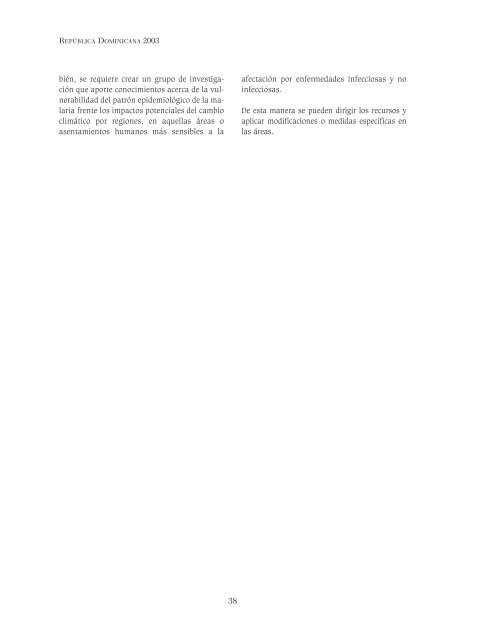CAMBIO CLIMATICO
CAMBIO CLIMATICO CAMBIO CLIMATICO
REPÚBLICA DOMINICANA 2003 bién, se requiere crear un grupo de investigación que aporte conocimientos acerca de la vulnerabilidad del patrón epidemiológico de la malaria frente los impactos potenciales del cambio climático por regiones, en aquellas áreas o asentamientos humanos más sensibles a la afectación por enfermedades infecciosas y no infecciosas. De esta manera se pueden dirigir los recursos y aplicar modificaciones o medidas específicas en las áreas. 38
PRIMERA COMUNICACIÓN NACIONAL 1.1 EXECUTIVE SUMMARY 1.1.1 Geography The Dominican Republics is located between the parallels 17° 36’ and 19° 58’ north latitude, and 68° 17’ and 72° 00’ west longitude. This places the country on the edge of the north tropical zone, with an extension of 48,670.82 km2, of which 1,575 km are coastline, with 526 km distributed along the north, 374 km on the east, and 675 km on the south. The Caribbean Sea lies to the south and east, and the Atlantic Ocean to the north. Hispaniola, along with Puerto Rico to the east, Cuba, to the northeast, and Jamaica to the southwest, belongs to the Greater Antilles group of the Caribbean Archipelago. It shares the island of Hispaniola with Haiti, occupying the eastern two thirds of the island. EXECUTIVE SUMMARY 1.1.2 Island Territory and Soil Conditions The Dominican Republic is home to an extremely varied terrain, illustrated by the fact that a vertical section going north-south can intercept seven large geomorphic regions that, listed from north to south, include a coastal plain; the Cordillera Septentriona,l or Northern Mountain Range; the Yaque del Norte River Valley, the largest in the country; and the Cordillera Central, or Central Mountain Range, with a maximum height of 3,150 meters above sea level. Directly to the south lie the San Juan River Valley; the Sierra de Neiba Mountain Range; the Sierra de Bahoruco Range, and a coastal plain on the south coast. These characteristics influence the island’s climatic conditions. Soils are classified into 7 groups according to the presence or absence of horizons, listed as follows: mollisols, vertisols, histasols, aridisols, ultizols, entisols, and inceptisols. 39
- Page 4 and 5: DIRECCIÓN GENERAL: Frank Moya Pons
- Page 7: AGRADECIMIENTO ESPECIAL A los sigui
- Page 10 and 11: REPÚBLICA DOMINICANA 2003 1.4.3.b
- Page 12 and 13: REPÚBLICA DOMINICANA 2003 2.5 MARC
- Page 14 and 15: REPÚBLICA DOMINICANA 2003 Climáti
- Page 17: PRÓLOGO
- Page 20 and 21: REPÚBLICA DOMINICANA 2003 las zona
- Page 23 and 24: PRIMERA COMUNICACIÓN NACIONAL INTR
- Page 25: 1CAPÍTULO RESUMEN EJECUTIVO REPORT
- Page 28 and 29: REPÚBLICA DOMINICANA 2003 Los suel
- Page 30 and 31: REPÚBLICA DOMINICANA 2003 1.2 LA R
- Page 32 and 33: REPÚBLICA DOMINICANA 2003 Como se
- Page 34 and 35: REPÚBLICA DOMINICANA 2003 el impac
- Page 36 and 37: REPÚBLICA DOMINICANA 2003 talidad
- Page 40 and 41: REPÚBLICA DOMINICANA 2003 1.1.3 Se
- Page 42 and 43: REPÚBLICA DOMINICANA 2003 October
- Page 44 and 45: REPÚBLICA DOMINICANA 2003 The cont
- Page 46 and 47: REPÚBLICA DOMINICANA 2003 average,
- Page 48 and 49: REPÚBLICA DOMINICANA 2003 measures
- Page 51 and 52: 2CAPÍTULO CIRCUNSTANCIAS GENERALES
- Page 53 and 54: PRIMERA COMUNICACIÓN NACIONAL 2.2.
- Page 55: PRIMERA COMUNICACIÓN NACIONAL nos,
- Page 58 and 59: REPÚBLICA DOMINICANA 2003 vechadas
- Page 60 and 61: REPÚBLICA DOMINICANA 2003 MAPA No.
- Page 62 and 63: REPÚBLICA DOMINICANA 2003 cial agr
- Page 64 and 65: REPÚBLICA DOMINICANA 2003 que esta
- Page 66 and 67: REPÚBLICA DOMINICANA 2003 bres no
- Page 68 and 69: REPÚBLICA DOMINICANA 2003 En el Ar
- Page 70 and 71: REPÚBLICA DOMINICANA 2003 de Medio
- Page 72 and 73: REPÚBLICA DOMINICANA 2003 2.7 SECT
- Page 74 and 75: REPÚBLICA DOMINICANA 2003 Plantas
- Page 76 and 77: REPÚBLICA DOMINICANA 2003 CLASE CU
- Page 78 and 79: REPÚBLICA DOMINICANA 2003 GRÁFICA
- Page 80 and 81: REPÚBLICA DOMINICANA 2003 CONT. CU
- Page 82 and 83: REPÚBLICA DOMINICANA 2003 CUADRO N
- Page 85 and 86: PRIMERA COMUNICACIÓN NACIONAL 3.1
- Page 87 and 88: PRIMERA COMUNICACIÓN NACIONAL CUAD
REPÚBLICA DOMINICANA 2003<br />
bién, se requiere crear un grupo de investigación<br />
que aporte conocimientos acerca de la vulnerabilidad<br />
del patrón epidemiológico de la malaria<br />
frente los impactos potenciales del cambio<br />
climático por regiones, en aquellas áreas o<br />
asentamientos humanos más sensibles a la<br />
afectación por enfermedades infecciosas y no<br />
infecciosas.<br />
De esta manera se pueden dirigir los recursos y<br />
aplicar modificaciones o medidas específicas en<br />
las áreas.<br />
38



